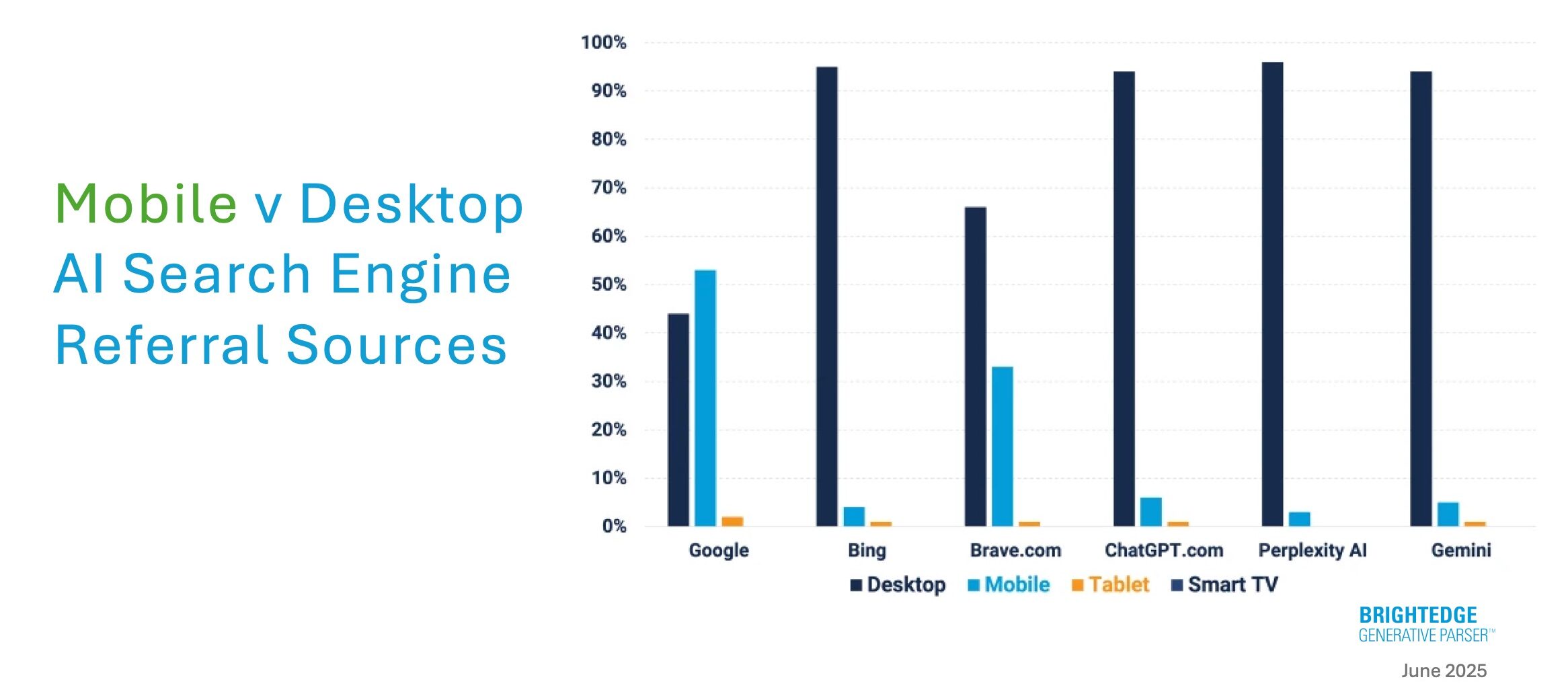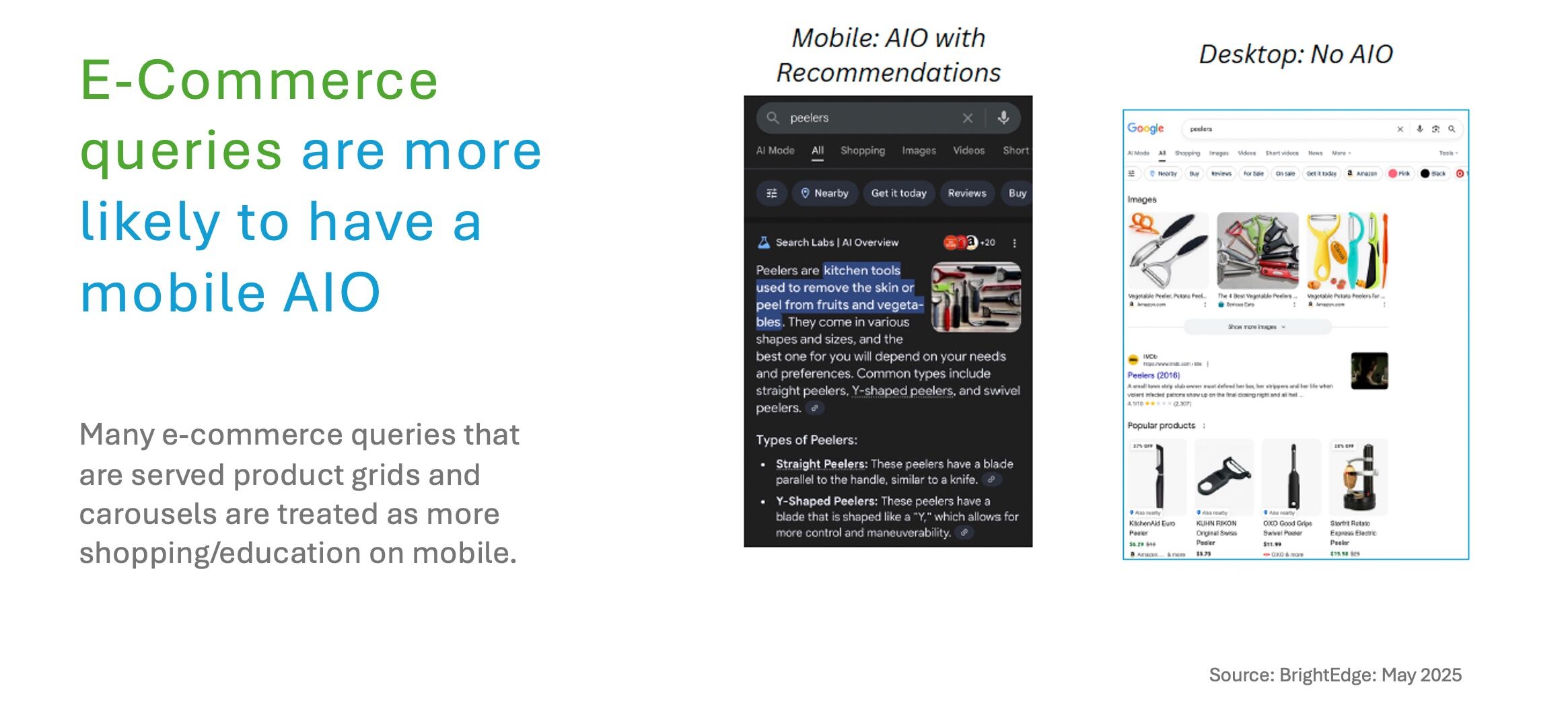The AI search revolution has arrived with fanfare, transforming how users discover information across platforms like ChatGPT, Perplexity, and Google’s AI Overviews.
Yet, beneath the headlines lies a counterintuitive reality that’s reshaping how we approach the age-old debate and strategies on desktop vs. mobile: Over 90% of AI-powered search referrals originate from desktop devices.
While mobile accounts for more than half of global web traffic, AI search engines are making their biggest impact on desktop – a complete reversal of typical user behavior patterns that creates both challenges and more mobile opportunities for marketers.
Currently, some of the findings I share below contradict conventional wisdom.
Recent analysis of referral traffic across leading AI search platforms in the U.S. and Europe shows a striking disconnect between where users consume content and where AI engines drive meaningful traffic.
This gap represents one of the most significant untapped opportunities in the current search landscape.
AI Desktop Vs. Mobile Referral Numbers Tell A Surprising Story
The data from BrightEdge Generative Parser (my employer for disclosure) paints a clear picture of desktop dominance across virtually every AI-powered search platform.
- ChatGPT leads the desktop concentration, with 94% of referral traffic coming from desktop devices, leaving just 6% for mobile users. This massive skew occurs despite ChatGPT’s widespread mobile app adoption.
- Perplexity pushes desktop dominance even further, with 96.5% of referrals originating from desktop and mobile barely registering at 3.4%. For a platform positioning itself as a research-focused AI engine, this pattern suggests that users prefer desktop environments for gathering in-depth information.
- Microsoft’s Bing maintains similar patterns, with 95% of desktop referrals vs. 4% mobile, despite integration across Microsoft’s ecosystem and the introduction of Copilot features.
- Google Gemini follows suit, with 91% of traffic coming from desktop and 5% from mobile, indicating that even Google’s AI offerings struggle to capture mobile referral momentum.
The lone exception? Google Search itself maintains the mobile majority at 53% mobile vs. 44% desktop, but this reflects its entrenched position as the default search engine across mobile browsers, particularly Safari on iPhones.
 Source: BrightEdge The Open Frontier of Mobile AI Search, June 2025
Source: BrightEdge The Open Frontier of Mobile AI Search, June 2025Why Mobile AI Search Isn’t Converting To Referrals
The disparity isn’t about user engagement; AI search activity on mobile is likely booming.
Instead, it’s about architectural design choices that fundamentally alter user flows and referral patterns.
The In-App Preview Problem
Mobile AI platforms often intercept the first click on citations, showing content previews within their own interfaces.
This creates a multi-step process where users must click again to reach external websites, significantly reducing referral traffic compared to desktop experiences, where first clicks typically lead directly to source sites.
ChatGPT exemplifies this pattern. On desktop, citation clicks immediately redirect users to source websites. On mobile, the app frequently displays in-app content previews, requiring users to take additional action to generate actual referrals.
The Discovery Vs. Research Divide
Desktop and mobile AI searches serve fundamentally different user intents.
Mobile users often engage in discovery-oriented searches, seeking quick answers, product comparisons, and immediate problem-solving.
Desktop users tend to gravitate toward comprehensive research, detailed analysis, and tasks that require sustained attention.
This behavioral split suggests AI platforms are evolving into distinct experiences rather than responsive versions of the same product.
Google’s AI Overviews demonstrate this evolution clearly: Ecommerce queries are three times more likely to trigger mobile AI Overviews (13.5% vs. 4.5% on desktop), treating shopping searches as educational discovery rather than direct product promotion.
Meanwhile, desktop AI Overviews command 80% more screen real estate (1110 px vs. 617 px) and appear for 39% more keywords than mobile devices, but show more consistent day-to-day patterns.
This suggests Google is actively experimenting with mobile AI formats while maintaining predictable desktop experiences.
The Apple Factor: Mobile’s Hidden Gatekeeper
Apple’s role as mobile web gatekeeper cannot be understated.
With Safari as the default browser on nearly a billion devices, Apple controls mobile search behavior in ways that could reshape the entire landscape overnight.
Current data shows that 58% of Google’s mobile search traffic to brand websites originates from iPhones, making Apple’s browser defaults critically important for AI search adoption.
Unlike Google, which has integrated AI features across its mobile search experience, Apple has not yet embedded AI-powered search into its mobile web stack.
This creates a massive structural opportunity. A single change in Safari’s default search provider or the introduction of native AI search features could trigger a significant redistribution of AI-powered traffic across the mobile ecosystem.
Three Strategic Imperatives For Marketers
1. Develop Device-Specific AI Content Strategies
Traditional SEO focuses on keywords and rankings, but AI search requires understanding device context and user intent patterns.
Mobile AI users prioritize quick discovery and shopping-oriented queries, while desktop users seek comprehensive information and detailed analysis.
Desktop-Comprehensive Approach
- Develop in-depth, research-oriented content that supports detailed analysis.
- Create comprehensive guides and comparative resources that leverage the 80% larger screen space available in desktop AI Overviews.
- Build authority through detailed explanations and expert insights.
- Design content clusters that support extended research sessions and take advantage of desktop’s 39% higher keyword coverage.
Mobile-First AI Optimization
- Create concise, discovery-focused content that answers immediate questions.
- Optimize for product comparison and shopping-related queries.
- Design content that works well in in-app preview formats.
- Focus on local and immediate-need content themes.
2. Prepare For Mobile AI Search When The Market Heats Up
The current desktop dominance in AI referrals represents a temporary market condition rather than a permanent state.
As mobile AI platforms mature and address current referral limitations, early movers will capture significant advantages.
Build Mobile AI Foundations Today
Responsive design excellence becomes critical when AI engines start citing mobile content more frequently.
Ensure your site adapts seamlessly across various screen sizes, orientations, and device modes to maximize citation potential regardless of how AI platforms display your content.
Optimize for speed and accessibility with fast page load times and mobile-friendly content that includes appropriately sized text, images, and interactive elements.
We are seeing AI engines increasingly factor user experience signals into their citation decisions. Schema markup is recommended so AI engines can interpret the structured data on your mobile pages and present users with content that they need and want.
Improve Core Web Vitals as these metrics become crucial for mobile AI performance. Core Web Vitals measure webpage quality beyond loading speed, correlating directly with user experience.
For mobile AI optimization, every millisecond matters – small improvements can have a significant impact on citation likelihood.
Track Desktop Vs. Mobile AI Performance
Monitor AI Overview differences using keyword reporting tools that switch between desktop and mobile AI Overviews.
This enables you to observe performance gaps and identify platform-specific opportunities.
The data reveals striking differences:
- Desktop AI Overviews claim 80% more screen real estate (1110 px vs. 617 px), allowing for more detailed explanations and citation opportunities.
- Desktop shows 39% more keyword coverage than mobile devices, but this gap represents a future mobile opportunity.
- Ecommerce queries are three times more likely to trigger mobile AI Overviews, as platforms treat shopping searches as educational discovery on mobile.
 Source: BrightEdge, May 2025
Source: BrightEdge, May 2025Have Different Content Strategies For Both Desktop And Mobile
Create mobile-first educational content and product guides rather than traditional product pages.
Mobile AI engines favor discovery-oriented content that helps users understand products and make informed decisions.
Ensure dual-platform accessibility by configuring your site’s crawling capabilities for both mobile and desktop views. Your content must be prepared for AI citation regardless of screen size or platform interface.
Watch Apple and Google industry moves: With Apple’s potential entry into AI search, content strategies should account for possible Safari integration changes that could dramatically shift mobile search behavior overnight.
3. Leveraging The Current Desktop Opportunity
While mobile AI search matures, desktop presents immediate opportunities for brands ready to optimize for AI-powered referrals.
- Desktop AI citation optimization: Focus on creating quotable, authoritative content that AI engines can easily cite and reference. This includes structured data markup, clear section headers, and direct answers to common questions.
- Comprehensive content development: Desktop AI users engage with longer-form, detailed content. Invest in comprehensive guides, thorough analysis, and expert commentary that support extended research sessions.
- Multi-modal content integration: Desktop environments support richer media experiences. Combine text, video, infographics, and interactive elements to increase citation potential across different AI platforms.
More Mobile AI Disruption Is Coming
The current 90% desktop dominance in AI referrals represents a temporary market imbalance rather than a permanent shift away from mobile. Several factors suggest significant mobile AI search growth ahead.
Platform incentives align toward mobile expansion. AI search companies understand that capturing mobile market share is essential for long-term growth, and current referral limitations likely drive the active development of mobile-optimized solutions.
User behavior patterns favor mobile AI adoption. Once technical barriers to mobile AI referrals are addressed, user preferences for mobile-first interactions should drive rapid adoption.
Apple’s AI integration timeline creates a sense of urgency. With Apple controlling mobile browser defaults and reportedly developing AI search capabilities, the mobile AI landscape could transform rapidly.
Key Takeaways
The AI search revolution is creating two distinct experiences: desktop-focused referral traffic and mobile-focused engagement that don’t yet translate to website visits. This divide presents both immediate opportunities and strategic imperatives for marketers:
Immediate opportunities exist in desktop AI optimization. With 90% of AI referrals coming from desktops, brands can capture significant traffic by optimizing for desktop AI search patterns and citation preferences.
Mobile AI strategy requires different thinking. Mobile AI optimization isn’t about responsive design. It’s about understanding discovery-focused user intent and preparing for different referral mechanisms as more AI search engines hit the market.
Apple remains the wild card. Any changes to Safari’s default search behavior or introduction of native AI features could reshape mobile search overnight, making preparation essential.
The brands that recognize this desktop-mobile divide and develop device-specific AI strategies will gain significant competitive advantages as the AI search ecosystem matures.
The question isn’t whether mobile AI search will grow. It’s whether your plan will be ready when it does.
The future of AI search lies not in choosing between desktop and mobile but in mastering both experiences as distinct opportunities to serve different user needs and capture referral traffic across the entire search journey.
Unless otherwise indicated, any data mentioned above was taken from this BrightEdge study. The data was for May 2025 and is based on thousands of actual website referrals for medium to large brands across the world.
More Resources:
- Google Discover, AI Mode, And What It Means For Publishers: Interview With John Shehata
- How To Get Brand Mentions In Generative AI
- The State Of AI In Marketing
Featured Image: Collagery/Shutterstock


